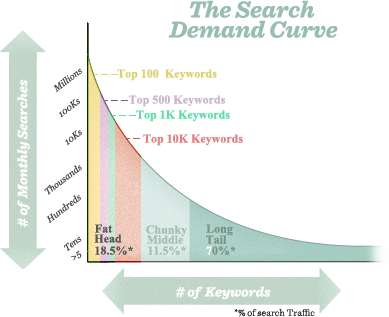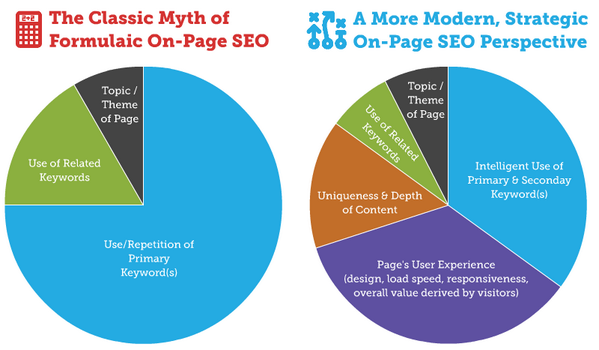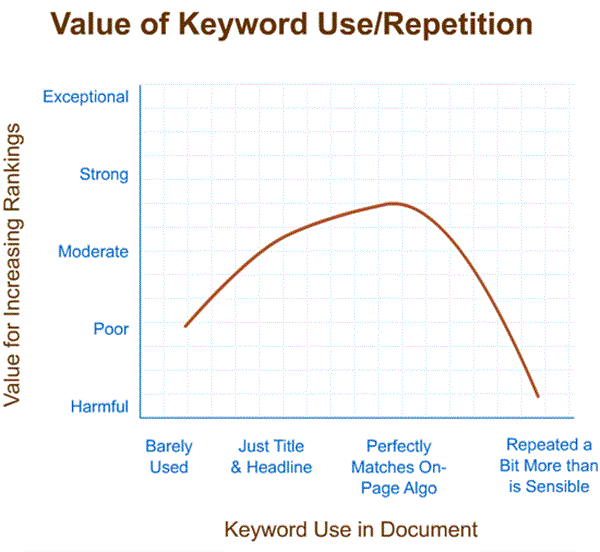The other day I was asked some questions about keyword optimization. They were questions that I’ve been asked before, so this time I decided to write a blog post about them.
Specifically the questions were:
- How many times show a keyword show up on a page to be effective?
- How many times is too many?
- Where should keywords appear – in titles, in the body, in the blog category list?
He also positioned the questions:
I have been trying to put more focus on writing my blog — as per your advice. I enjoy writing and I want to produce quality writing.
I don’t want to just create posts that are a bunch of keywords strung together with some transitional phrases. At the same time, I want people to be able to find my content when they do a search, so I understand that keywords are important.
I think this is a point we all come to, sooner rather than later.
Nobody wants to read content that’s stuffed with so many keywords that it sounds like something that came out of a robot.
But to really answer these questions we have to take a step back and look at keyword research, the process that happens before keyword optimization.
According to Moz, keyword research is:
One of the most important, valuable, and high return activities in the search marketing field. Ranking for the “right” keywords can make or break your website.
At its simplest, identify keywords that offer the best ratio of:
- Low competition
- High traffic
- High relevance
What does that mean?
Competition is easy to explain – it’s how difficult it will be to rank in a high position for any particular keyword. For example, trying to rank for ‘shoes’, ‘consultant’, ‘web hosting’, or ‘dating site’ will be extremely difficult because there’s a lot of competition for those short, popular words.
Traffic is the number of people searching for a particular keyword – there’s little point in ranking #1 for a keyword that no one ever searches for. (However, we’ll explain a little further down why this isn’t quite as true as it used to be)
Relevance: If you are a massage therapist, there’s little value in ranking for used cars. The terms you want to target should be relevant for people researching or looking to purchase your services. Sometimes a little creative thinking here goes a LONG way. It’s not just about getting visitors to your site – but getting the right kind of visitors.
When targeting keywords, ask yourself: Is the keyword relevant to my business, and to my website?
Will someone find what they’re looking for on my site if they come here having searched for that term?
If the answer is no – don’t target it (or, if it is relevant to your business, but the searcher won’t find what they’re looking for – then better yet, create content for it!).
Long Tail vs Top Keywords
The next important thing to pay attention to is what are called ‘long-tail’ vs popular or top keywords.
Every beginner starts out trying to rank for popular terms. Realtors, for example, almost always go for ‘real estate’. There was a time, back in the hazy early days of the internet when you could maybe do that and stand a chance of success. Today, you’ll simply be wasting your time.
When you’re starting your SEO process – you want to start with the long tails.
Popular searches account for 30% of all web traffic. But 70% of all searches are long-tails!
Long tails consist of hundreds of millions of unique searches that might only be searched for a few times a day, but when taken together, they are the vast majority of humankind’s interaction with search engines.
And, they often convert better than the more generic, popular keywords.
Intent
A person searching for ‘massage’ for example is probably just browsing, maybe even just bored.
Someone searching for ‘best gentle masseuse downtown Vancouver’ is likely to pick up the phone and book right then and there if your website delivers the info they’re looking for. Not only will it be a lot easier to rank for that, but the traffic you get will be much more targeted, relevant and specific.
Optimize
Optimize for success by focusing on long-tail keywords that are highly relevant to your business and have reasonably low competition levels. Checking competition levels is an art-form in itself, but for now you can leave it to keyword research tools that will give you an approximation (low, med, high) – avoid the highs, target the lows and mediums.
By choosing many keywords grouped around a theme, you’ll optimize for the long-tails in that area, and eventually begin to rank for a ton of other long-tails that you haven’t even specifically targeted.
This is the magic of having a body of content on your site that’s all related – a single blog post doesn’t just stand on its own – it’s taken into consideration along with a ton of other factors, including what kind of other content is on your site.
So now that you’ve chosen an area to work on, and generated related keywords (using tools like Spokal’s Keyword Research tool, or the Google Adwords tool), how do you maximize your content to rank for them?
Keyword Optimization
First – there’s the old-school approach:
Make sure the keyword is mentioned a few times in your post. The actual number of times has decreased in importance, but for the sake of a starting guideline let’s say between 1% and 4% of your blog content. So that means, if for example your keyword is ‘blue suede shoes’, and your blog post is 1000 words long, that the keyword should be repeated 3-12 times. ((blog length / keyword length) * %)
DO NOT KILL YOURSELF TRYING TO ACHIEVE THIS!
It’s just a guideline.
Sometimes it’s fine to be a little lower. This post, for example is actually under 1% for keyword optimization. But we’re already breaking the rules because it’s not really a long-tail. Sometimes it just feels good to write something that will be of use, without worrying too much about the SEO.
Some things you should follow
- Your keyword should be in your title if you can swing it. Don’t force that, it’s better to have an enticing headline than an SEO optimized one, but if it fits, having a keyword in the title is valuable.
- Include your keyword in at least one heading. You’ll notice that we typically use a lot of headings in our content – it serves to break up posts and makes skimming easier. Make sure your keyword is in at least one heading.
- It should be in one alt or title tag in at least one image in your post.
That’s 3 times and you haven’t even put any in the body of your content yet.
That’s pretty simple to do with a short keyword, but if you’re going after long tails, you might have something more like ‘affordable starter home in kitsilano’ – as an example. It’s tough to squeeze that in a bunch of times without starting to sound a little robotic.
Our advice is don’t try. Optimize for the reader first, and for SEO second.
Google is much much smarter now than it used to be. You don’t have to only use exact match keywords. You can also use other, similar terms like ‘inexpensive starter home in Kitsilano’, or ‘inexpensive homes in Kitsilano’ – this will help with your primary push on ‘affordable starter home in Kitsilano’.
Our process is to write blog posts for humans, and then only after we’re done, go over it and make some minor edits for SEO.
Always asking with each edit – are we making this harder to read? If we are, then we don’t do it. Sometimes we find ways to make it even better to read AND increase SEO, sometimes we increase the SEO score without impacting readability, but we never want to compromise the quality of our posts for a minor uptick in SEO score.
A note on SEO Graders
One thing to note is that most SEO tools (Spokal’s included for now) will only check for an exact keyword match, and Google is much, much smarter than that, so you’ll have to use your human intelligence in this case – if the tool is telling you that your keyword density is too low, but you know you’ve used a few closely related terms in there too, then you’re probably okay.
You can make associations like that at a much more advanced level than most computers, so go ahead and chuckle at the computer now, before they take over the world.
Despite their shortcoming in identifying related keywords, there are plenty of other ‘traditional’ rules in SEO graders that still make a lot of sense. For example, keyword density is just one rule out of 8 that Spokal’s SEO grader checks for.
The others – like including your keyword in a heading, minimum blog length, using the keyword in the meta description (not really for SEO, but for optimizing click-through rates), not having any photos or any links in your post, alt tags with the keywords in them, and keyword in the title – they’re all useful guidelines. Even as Google gets smarter these are the things you can do to help it along.
So, back to the original 3 Qs
1. How many times should a keyword show up on a page to be effective?
The traditional answer is between 1 and 4% of the blog length ((# of blog words / keyword length * %)
So in a 1000 word blog post, if your keyword is 4 words long, you’d want to have it 2.5 – 10 times.
Remember that closely related words can be used as substitutes so you’re not repeating the same phrase over and over again. In fact, even though you’ll fool some SEO tools, you’ll likely do better in Google than if you tried to copy the exact phrase over and over.
2. How many times is too many?
If it’s annoying to the reader, it’s too many. If you’re over 5%, it’s almost certainly too many.
3. Where should keywords appear — in titles, in the body, in the blog category list?
It should appear in the title – if it works there. Don’t force it. It should appear in a header in your blog, and in the body. It should probably be in an alt or title tag on one of the images on your blog post, and if you link to the post from another post on your site, you should link it with the keyword text you’re targeting.
The days of having the keywords in tags and categories are over, don’t worry about that.
Art, not a science
And finally – SEO, keyword research and keyword optimization is an art, not a science.
These are general guidelines that will serve you well when you’re starting out, but you’ll find all sorts of other advice out there – much of it will be along similar lines, some if it will likely be radically different. This is my take on the state of things now, and how we do keyword research and optimization here.
At the end of the day, if you focus on the reader first, and keyword optimization very much a distant second, you likely won’t go wrong. Keyword optimization (in terms of keyword density and placement on pages) has an ever decreasing part to play in how pages get ranked and what they get ranked for.
While they’re still important to focus on, it’s just not as important to obsess over anymore. Backlinks and social media shares are playing ever increasing roles in overall rankings – and to get those, you need to have good content, so it would be counter-productive to try to optimize for keywords if it meant the end result was a less pleasant, fun, or educational read.
How is that cheating?
It’s not.
But it feels like it is because so little thought needs to go into it once we’ve done the research.
Spokal’s SEO grader just does it all for us. If you don’t use Spokal, we also recommend the free Yoast plugin which can also help with SEO grading.
If you want to read more on this subject, I recommend this post by Rand Fishkin at Moz, and their beginner guide.




